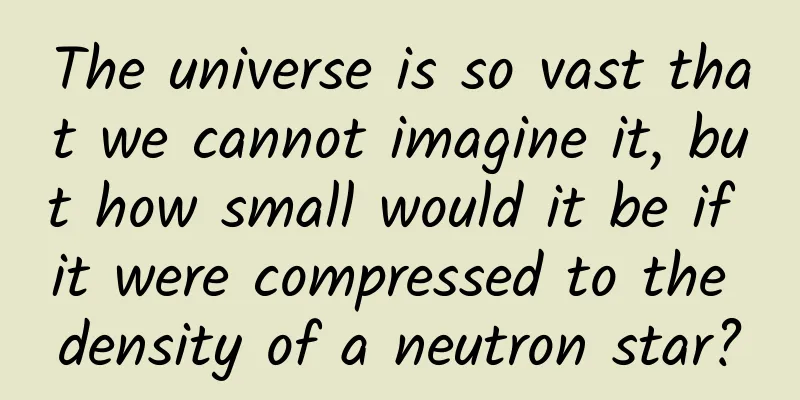The universe is so vast that we cannot imagine it, but how small would it be if it were compressed to the density of a neutron star?

|
This article is based on answering similar questions from netizens: This is a brain-opening question. Based on known scientific knowledge, you can figure it out with a simple calculation. First, we need to determine the size of the universe. If we don't know the size of the universe, we can't answer such questions. But now the scientific community has not reached a consensus on the size of the universe, so we can only make a rough assessment based on existing theories. In the past, Newton's era adhered to the absolute view of the universe, which held that the universe was static, boundless, without beginning or end. This made it impossible to determine the size of the universe. How could one calculate how big the universe would be if the nuclei and electrons of all the atoms in the universe were close together without leaving any gaps? Modern cosmology believes that the universe is dynamic, time and space are relative, and originated from the Big Bang 13.8 billion years ago. After 13.8 billion years of expansion, the universe has expanded from an infinitely small singularity to a very large one, but we don’t know how big it has expanded to. We only know that the diameter of the observable range of the universe is about 93 billion light years. There is an unobservable universe outside this range, and we don’t know how big it is. The Big Bang theory has become the standard cosmological model of modern cosmology, because since the model was proposed, all scientific observations and discoveries have been consistent with the model's expectations. Therefore, when we answer this question now, we will use such a cosmic scope for calculation. With the scope of the observable universe, we also need to understand how much mass is included in this scope. The mass of the observable universe is also an estimate. Some people believe that there are at least 1 trillion galaxies like the Milky Way in the observable universe based on some data from cosmic observations in recent years. The Milky Way has about 200 billion solar masses, and the mass of the sun is about 2*10^30kg. Therefore, the mass of the universe is approximately: (2*10^30)*(2*10^11)*(1*10^12)=4*10^53kg Another algorithm is based on the average density of the universe. There was a cosmological constant λ in Einstein's field equations. Later, based on Hubble's observations, Einstein determined that the constant was deleted after the universe expanded. However, the scientific community later discovered that this constant was very important and used it to calculate the density of the universe to be 1, which means that there is only one particle in 1 cubic meter of space, and the mass of a proton is about 1.67*10^-27kg. If we calculate the mass of the observable universe based on this, we get: The total volume of the observable universe is ≈4/3*3.1416*[(4.65*10^10)^3]=4.2*10^32 cubic light years Converted to cubic meters ≈ (4.2*10^32)*(8.47*10^47)=3.56*10^80m^3 The total mass of the observable universe ≈ (3.56*10^80m^3)*(1.67*10^-27)=5.95*10^53kg The total mass of the universe obtained by these two calculations is similar. On a large scale, any measurement can only be an approximation, and it is difficult to get accurate data. Today, we will use the total mass of the universe calculated by that galaxy as 4*10^53kg to calculate. However, this mass is only the mass of visible matter. Modern research believes that 95.1% of the mass-energy in the universe is composed of dark energy and dark matter. Today, the scientific community cannot see these, and cannot give an accurate answer to what they are, so we will not discuss them today. Now let's talk about the density of atoms and atomic nuclei. In fact, the scientific community has long discovered that there are substances with atomic nuclei density in the universe. This is neutron star matter, called neutron degenerate matter. This kind of matter is under the extreme pressure of neutron star 10^28 atmospheres. The electrons outside the nucleus of the matter are completely crushed, the atoms are crushed, the electrons are compressed into the nucleus, and the negative charge of the electrons is neutralized with the positive charge of the protons to become neutrons. In this way, the entire planet is like an atomic nucleus composed entirely of neutrons. Scientific research shows that the density of an atomic nucleus is about 10^17kg/m^3, which means that each cubic centimeter is 100 million tons. It is generally believed that the density of a neutron star is in the range of 10^17~2*10^18kg/m^3, which means that 1 cubic centimeter is 100 to 200 million tons. It can be seen that the density of a neutron star is sometimes greater than that of an atomic nucleus. All common substances around us are composed of atoms. The density of water is only 1g/cm^3 (grams per cubic centimeter), and the density of gold is only 19.32g/cm^3. Since the density of the nucleus is so high, why is the density of common substances so low? This is because atoms have an outer shell of electrons. Electrons are very light, but they support the huge space of the atom. The nucleus, which occupies 99.96% of the total mass of the atom, is shrunk in the core of the atom, occupying only one trillionth of the volume. In this way, we can calculate that if water is compressed 100 trillion times, each cubic centimeter will have 1 billion tons; and if gold is compressed 100 trillion times, each cubic centimeter will have 1.932 billion tons. In fact, the density of the nucleus should be the same. The density of water compressed into a nucleus and gold compressed into a nucleus should be the same. Therefore, the nuclear density mentioned above is 1*10^17kg/m^3, and the volume of the nucleus is only one trillionth of the atom. These data are only approximate and relative, especially the ratio of the volume of the nucleus to the atom, which varies greatly from one atom to another. So, if the entire universe becomes a tightly packed atomic nucleus, how big would it be? In fact, the entire universe is incredibly empty, with an average density of only 1.67*10^-27kg/m^3, which means that the average mass per cubic meter is only 167 billion billionths of a kilogram, which is emptier than any highest vacuum we know or have created. So how big would the volume be after the total mass of the observable universe, 4*10^53kg, is compressed into the density of an atom? Simple calculation: 4*10^53/1*10^17=4*10^36m^3, which is about 4 trillion trillion trillion cubic meters. Each cubic kilometer is 1 billion cubic meters, therefore, the volume of the observable universe of atomic nuclei is: 4*10^36/1*10^9=4*10^27/km^3, or 400 trillion trillion cubic kilometers; each cubic light-year is about 8.47*10^38km^3, and this universe is only 4.72*10^-12 cubic light-years, or one trillionth of a cubic light-year. The observable universe of this nuclear density is very small. It no longer needs to be measured in light years. It is measured in kilometers or astronomical units (AU). The radius of the sphere of this observable universe is only about 985 million kilometers, less than 5.6 AU (1 AU is about 150 million kilometers). The average distance from Jupiter to the sun is about 779 million kilometers, and the average distance from Saturn to the sun is about 1.43 billion kilometers. Therefore, this nuclear density observable universe is only a sphere with a radius between the sun and Jupiter and Saturn. It can be seen that if the universe becomes a neutron star, it will be just a sphere with a radius of less than 1 billion kilometers. This idea is not completely out of the blue. It is likely to be the state at the end of the universe. The modern standard model of the universe believes that the universe grows from small to large. At the beginning, it was a singularity whose volume could not be measured. Compared with a 1 billion kilometer ball, it is completely negligible. Modern black hole theory believes that all the mass of a black hole exists in the singularity at the core. Therefore, the density of a neutron star is dwarfed by that of a black hole. There is a theory of the destination of the universe that holds that when the universe expands to a critical point, the expansion force and the contraction force will form a balance, and then gravity will dominate to cause the contraction of the universe. As the contraction accelerates, it will eventually form a collapse trend and will inevitably go through the nuclear density stage, which is the neutron star stage. Under the huge mass pressure of the universe, this stage will be very short, and it will collapse into a black hole in an instant, the universe will return to the singularity, time and space will end, and the universe as we know it now will disappear. There are many theories about the fate of the universe, and this is just one of them. Regardless of which theory, the universe still has at least tens of billions of years to exist, while the solar system has only 5 billion years to live. No one can predict how many years humans can exist. Today's discussion of this issue is just to share with you some basic knowledge of the universe. Thank you for reading and welcome to discuss. The copyright of Space-Time Communication is original. Infringement and plagiarism are unethical behavior. Please understand and cooperate. |
<<: The curling competition is getting hot! Do you understand these "curling languages"?
>>: How did people prevent earthquakes and provide disaster relief in ancient society?
Recommend
Apple HomePod? We'll just see if we actually buy it or Echo
According to AppleInsider, a survey released on W...
“Activity Lottery”, how to achieve a growth of 50 million?
When it comes to lotteries, you may think of draw...
How much does it cost to join a photography mini program in Tangshan?
How much does it cost to join a photography mini ...
How to release a trial version of a WeChat mini program?
Q: How to release the WeChat Mini Program trial v...
Using a fire extinguisher as a toy, researching chips in a chemical laboratory... "Professional flaws" frequently appear in film and television dramas. Don't treat science as a joke!
Recently, a popular TV series reflecting the dail...
Kuaishou APP product analysis report!
In this article, I will start with the developmen...
Honor Play 7X review: A flagship phone worth 1,000 yuan with full screen performance
Honor Play 7X was just released on the afternoon ...
How to market effectively in the second half of 2019?
Entering 2019, marketing seems to be facing its b...
Everything on the cloud is connected to the Internet of Things, Coocaa System 8's way to break the circle
The OTT industry has once again become a hot spot...
Steady and elegant, it looks like an elephant's footprint, but it's actually a plant...
In the wonderful world of succulents, the Ivory P...
Sogou promotion case: a high-quality traffic expansion solution that increased clicks by 60%!
Today, the editor brings you a classic and high-q...
Android 12 will make it easier to update the operating system: you can update it through the app store
Google has launched Project Mainline to improve t...
The form of opening screen advertising!
Mobile advertising comes in many forms. For mobil...
#Popular Science in Progress# This "four-legged snake" on the stone slab is more than 200 million years old
In 1957, Mr. Hu Chengzhi, a researcher at the Nat...
WeChat public account data analysis skills!
How to make good use of the public account backen...









